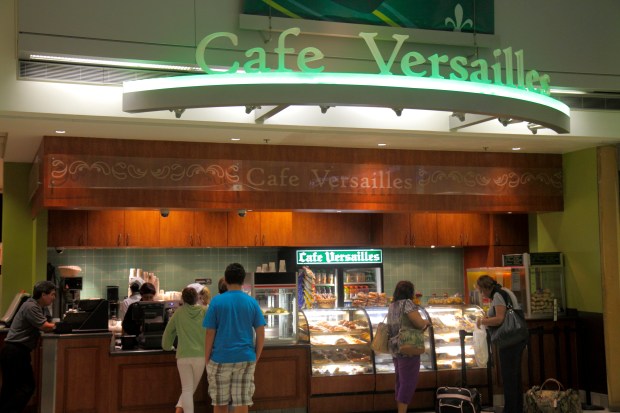A certain craving always starts to set in as my plane touches down at Miami International Airport. Whether Miami is the destination or simply a point of connection to somewhere else, I know what I’m having as soon my plane has rolled to its gate, I’ve lowered my bag from the overhead bin, and shuffled off the plane. The order is always the same, after all: a cafe cubano, two croquetas de jamon, and a guava and cheese pastelito from the airport outpost of a Miami institution, Versailles.
How can airport food inspire this kind of excitement and even devotion? Perhaps it’s because these small versions of Versailles (there are four at Miami’s main airport) offer a taste of what I go to the city for, a preview of or a farewell to what lies beyond the security gates and baggage claim. Or perhaps it’s because this airport is a hub for more flights to and from Latin America than any other in the United States and is frequently a stopover for me en route to destinations farther south like Brazil, Argentina, and Nicaragua. In these instances, the airport Cafe Versailles serves not only cubano sandwiches and fruit shakes but also an amuse bouche of what awaits me after my connecting flight: being called cariño by strangers, strong coffee, the flavors of tropicalia.
The branches of Cafe Versailles at the airport are diminutive compared with their capacious flagship in Little Havana, with its chandeliers, green vinyl seats, extensive laminated menus, and uniformed waiters. The famed Cuban diner on Calle Ocho bustles with life all day long, between the folks who gather for cafecitos and sweets at the cafe counter and the tourists and regulars who fill the main dining room and chat noisily over plates of ropa vieja, plantains, and black beans.
Since its founding in 1971 by Felipe Valls Sr., an exile from Santiago de Cuba, the restaurant has been the town square for Miami’s Cuban exile community. It’s a de rigeur stop for all stripes of politicians campaigning in Florida, and it’s where, in 2016, hordes of Miamians gathered in the parking lot and on sidewalks to bang pots and pans to celebrate the death of Fidel Castro. Yet the restaurant’s cultural significance outweighs its political one. It’s at once an homage to a country left behind—in the owners’ words, a restaurant “founded to feed and assuage the nostalgia of a people”—and a place so staunchly rooted in Miami that it’s hard to imagine the city without it.
I even love the way the small white paper bags carrying my treats quickly develop translucent spots from the dripping richness of the croquetas and pastelito.
Sure, these airport versions of Versailles offer only a stripped-down version of the iconic restaurant, but I love that they capture a flash of the sazón that lies outside this sterile space or just beyond my next flight. I love knowing that when my turn comes in line, if I pronounce my order with a respectable Spanish accent, the counter staff will speak to me en español all the way down the rest of the line, even though I am still in the United States. I even love the way the small white paper bags carrying my treats quickly develop translucent spots from the dripping richness of the croquetas and pastelito. There’s comfort to be found even in the rituals of adventure, a savoring of the journey at each point along the way.
This ritual of Miami-ness is even more surprising when you consider that airports are, in many ways, the ultimate placeless places. With few deviations from the rule, their architecture is one of sameness: antiseptic corridors of chain stores and food courts, definitively separated from the city outside by security and customs checkpoints. These are spaces belonging to neither the place of departure nor the destination but simply to transit, to movement. Take a journey with multiple connections through several time zones, and you’ll lose all sense of place navigating these spaces.
And yet when cities try to imbue their airports with nods to regional culture—take the yoga rooms at San Francisco’s SFO, live rock bands at Seattle’s Sea-Tac, or even the slot machines at McCarren in Las Vegas—these attempts so often feel like a commodification of local culture, as reductive and engineered for the tourist as the souvenirs sold at the nearby kiosks and magazine stands.
Yet to me, Cafe Versailles at MIA doesn’t feel like a commodified version of Miami, a poor facsimile of the place. It is the real thing. Flanked by chain restaurants and gift shops, you can’t help but have the feeling that the Cafe Versailles at the airport is more for the local residents departing and returning to Miami than it is for the tourists passing through. And I feel lucky to be in the know.
